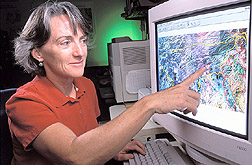This page has been archived and is being provided for reference purposes only. The page is no longer being updated, and therefore, links on the page may be invalid.
| New Aid for Savvy Stewardship of Southwestern RangelandsBy Marcia WoodDecember 30, 2002 Wildlands that border Arizona's scenic Upper San Pedro River are covered with hardy grasses and rugged desert shrubs. But hungry cattle could easily overgraze these tasty, nutritious plants. In turn, overgrazing can lead to flooding and erosion. To prevent that from happening, scientists at the Southwest Watershed Research Center at Tucson, Ariz., are readying a new, computer-based aid that the region's ranchers, wildlife managers and other specialists can use to safeguard this ecosystem. The researchers' invention converts--into numerical form--details about the rangelands. This information comes from satellite imagery, weather records and studies of how rangeland plants grow. The Tucson center is part of the Agricultural Research Service. With mathematical formulas or equations that the ARS scientists wrote, an ordinary personal computer can process this information into customized color maps and other helpful printouts. These display projections of what plants will be available for the animals in coming months, and where those plants will be found, given expected weather conditions. The researchers have dubbed their new, computer-driven mathematical model "SEHEM," short for "Spatially Explicit Hydro-Ecological Model." M. Susan Moran, hydrologist and research leader at the Tucson center, and Yann Nouvellon, a NASA-funded ecologist, led the work. Computer models that forecast weather and simulate plant growth aren't new. What makes SEHEM unique is its reliability and validity over a very large area--hundreds of square miles. Moran, Nouvellon and co-workers tested SEHEM by asking it to project rangeland plants' growth for specific periods. For the test, they chose periods of time for which they already had accurate information. When they compared SEHEM's projections to these records from earlier years, they found that the SEHEM output was very close to what had actually occurred on the rangelands. To further improve SEHEM, Moran and colleagues are now fine-tuning the equations that drive it. By 2004, she expects to have a practical, easy-to-use version ready for users to try out. What's more, Moran will make SEHEM the basis for a similar model for the Great Basin rangelands of Utah, Idaho, and Nevada. ARS is the U.S. Department of Agriculture's chief scientific research agency. |


